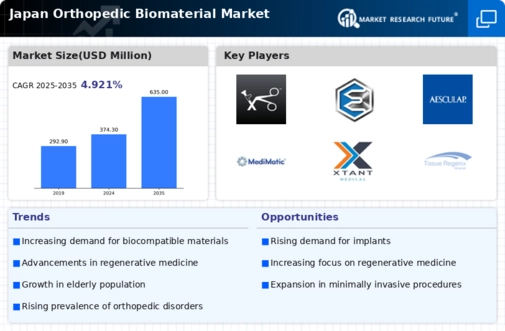Focus on Personalized Medicine
The orthopedic biomaterial market in Japan is witnessing a shift towards personalized medicine, which is becoming a key driver of market growth. This approach emphasizes tailoring treatments to individual patient needs, particularly in orthopedic surgeries. Advances in biomaterials that can be customized for specific patient profiles are gaining traction. For example, 3D printing technology is being utilized to create patient-specific implants that enhance fit and functionality. This trend is expected to revolutionize the orthopedic biomaterial market, as personalized solutions may lead to improved surgical outcomes and patient satisfaction. As healthcare providers increasingly adopt personalized approaches, the demand for innovative biomaterials is likely to rise.
Increasing Healthcare Expenditure
Japan's healthcare expenditure is on the rise, which is positively impacting the orthopedic biomaterial market. The government has been increasing its budget for healthcare services, with a focus on improving patient care and access to advanced medical technologies. In 2025, healthcare spending is expected to reach approximately $500 billion, reflecting a commitment to enhancing the quality of healthcare services. This increase in funding is likely to facilitate the adoption of advanced orthopedic biomaterials, as hospitals and clinics seek to provide the best possible care for patients undergoing orthopedic procedures. Consequently, the orthopedic biomaterial market is poised for growth as healthcare providers invest in high-quality materials.
Investment in Research and Development
Investment in research and development (R&D) is a critical driver for the orthopedic biomaterial market in Japan. The government and private sector are increasingly allocating funds to explore new biomaterials and improve existing ones. This focus on innovation is evident in the establishment of specialized research centers and collaborations between universities and industry players. For instance, the Japanese government has set aside approximately $500 million for R&D initiatives aimed at advancing orthopedic technologies. Such investments are expected to lead to breakthroughs in biomaterials that offer superior biocompatibility and mechanical properties, thereby enhancing the overall performance of orthopedic implants and devices.
Rising Demand for Joint Replacement Surgeries
The orthopedic biomaterial market in Japan is experiencing a notable surge in demand for joint replacement surgeries. This trend is primarily driven by an increasing prevalence of orthopedic conditions such as osteoarthritis and rheumatoid arthritis among the aging population. According to recent data, the number of total knee arthroplasties performed annually in Japan is projected to reach approximately 1 million by 2025. This growing demand for surgical interventions necessitates the use of advanced biomaterials, which are essential for ensuring the longevity and effectiveness of implants. As a result, the orthopedic biomaterial market is likely to expand significantly, with a focus on developing innovative materials that enhance patient outcomes and reduce recovery times.
Growing Awareness of Minimally Invasive Procedures
There is a growing awareness and preference for minimally invasive surgical procedures among both healthcare providers and patients in Japan. This shift is influencing the orthopedic biomaterial market, as these procedures often require specialized biomaterials that can facilitate quicker recovery and reduced postoperative complications. The market for minimally invasive orthopedic surgeries is anticipated to grow at a CAGR of around 8% over the next five years. As surgeons increasingly adopt these techniques, the demand for advanced biomaterials that support such procedures is likely to rise, driving innovation and competition within the orthopedic biomaterial market.























Leave a Comment